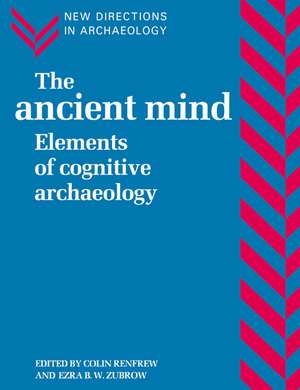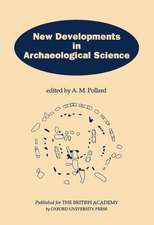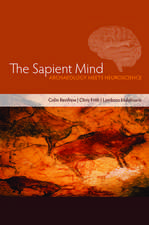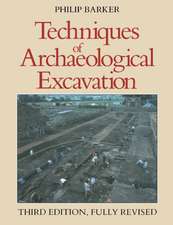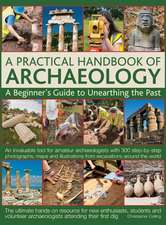The Ancient Mind: Elements of Cognitive Archaeology: New Directions in Archaeology
Editat de Colin Renfrew, Ezra B. W. Zubrowen Limba Engleză Paperback – 25 mai 1994
Din seria New Directions in Archaeology
-
 Preț: 391.19 lei
Preț: 391.19 lei -
 Preț: 325.50 lei
Preț: 325.50 lei -
 Preț: 291.30 lei
Preț: 291.30 lei -
 Preț: 287.56 lei
Preț: 287.56 lei -
 Preț: 391.19 lei
Preț: 391.19 lei -
 Preț: 284.39 lei
Preț: 284.39 lei -
 Preț: 308.34 lei
Preț: 308.34 lei -
 Preț: 407.42 lei
Preț: 407.42 lei -
 Preț: 382.89 lei
Preț: 382.89 lei -
 Preț: 389.84 lei
Preț: 389.84 lei -
 Preț: 288.04 lei
Preț: 288.04 lei -
 Preț: 322.62 lei
Preț: 322.62 lei -
 Preț: 313.85 lei
Preț: 313.85 lei -
 Preț: 284.56 lei
Preț: 284.56 lei -
 Preț: 285.16 lei
Preț: 285.16 lei -
 Preț: 285.54 lei
Preț: 285.54 lei -
 Preț: 288.62 lei
Preț: 288.62 lei -
 Preț: 282.10 lei
Preț: 282.10 lei -
 Preț: 282.10 lei
Preț: 282.10 lei -
 Preț: 285.16 lei
Preț: 285.16 lei -
 Preț: 284.17 lei
Preț: 284.17 lei -
 Preț: 285.93 lei
Preț: 285.93 lei -
 Preț: 293.42 lei
Preț: 293.42 lei -
 Preț: 284.56 lei
Preț: 284.56 lei -
 Preț: 287.87 lei
Preț: 287.87 lei -
 Preț: 287.48 lei
Preț: 287.48 lei -
 Preț: 205.53 lei
Preț: 205.53 lei -
 Preț: 285.16 lei
Preț: 285.16 lei -
 Preț: 284.98 lei
Preț: 284.98 lei -
 Preț: 285.16 lei
Preț: 285.16 lei -
 Preț: 285.16 lei
Preț: 285.16 lei -
 Preț: 283.79 lei
Preț: 283.79 lei -
 Preț: 284.56 lei
Preț: 284.56 lei -
 Preț: 282.26 lei
Preț: 282.26 lei -
 Preț: 285.37 lei
Preț: 285.37 lei -
 Preț: 286.13 lei
Preț: 286.13 lei -
 Preț: 297.58 lei
Preț: 297.58 lei
Preț: 392.18 lei
Nou
Puncte Express: 588
Preț estimativ în valută:
75.04€ • 78.56$ • 62.09£
75.04€ • 78.56$ • 62.09£
Carte tipărită la comandă
Livrare economică 05-19 aprilie
Preluare comenzi: 021 569.72.76
Specificații
ISBN-13: 9780521456203
ISBN-10: 0521456207
Pagini: 212
Ilustrații: 41 b/w illus. 6 maps 15 tables
Dimensiuni: 189 x 246 x 11 mm
Greutate: 0.4 kg
Ediția:New.
Editura: Cambridge University Press
Colecția Cambridge University Press
Seria New Directions in Archaeology
Locul publicării:Cambridge, United Kingdom
ISBN-10: 0521456207
Pagini: 212
Ilustrații: 41 b/w illus. 6 maps 15 tables
Dimensiuni: 189 x 246 x 11 mm
Greutate: 0.4 kg
Ediția:New.
Editura: Cambridge University Press
Colecția Cambridge University Press
Seria New Directions in Archaeology
Locul publicării:Cambridge, United Kingdom
Cuprins
Foreword; Part I. Introduction: 1. Towards a cognitive archaeology; Part II. The Interdisciplinary Underpinning: 2. Interpretations and testability in theories about prehistoric thinking; 3. Archaeology and cognitive science; 4. From mental modularity to generalized intelligence: a cognitive interpretation of the Middle/Upper Paleolithic transition; 5. Are images animated? The psychology of images in Ancient Greece; Part III. Approaches to Cult Practice and Transcendental Belief Systems: 6. The archaeology of religion; 7. Ancient Zapotec ritual and religion: an application of the direct historical approach; 8. The meaning of death; 9. Prehistoric cognition and the science of archaeology; Part IV. Prehistoric Conceptions of Space and Time: 10. Symbols and signposts: understanding the prehistoric petroglyphs of the British Isles; 11. Knowledge representation and archaeology: a cognitive example using GIS; 12 Dials: a study in the physical representation of cognitive systems; Part V. The Material Basis of Cognitive Inference: Technology: 13. Cognitive aspects of 'technique'; 14. Mindful technology: unleashing the Chaîne Opératoire for an archaeology of mind; 15. Prehistoric technology: a cognitive science?; Part VI. The Material Basis of Cognitive Inference: Writing Systems; 16. Variation and change in symbol systems: case studies in Elamite Cuneiform; 17. Figure and text in Mesopotamia: match and mismatch; Part VII. Conclusion: 18. Cognitive archaeology reconsidered.
Recenzii
"...an important reference work for any library that attempts to stay abreast of current developments in archaeology." Dennis E. Smith, Religious Studies Review
Descriere
This book develops a new direction in prehistoric cognitive research which is rooted in science and empirical methodology.
